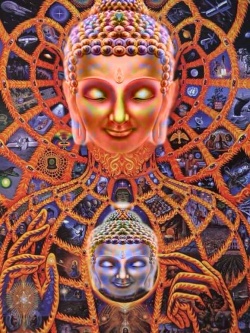Three standards of comparison
three standards of comparison
三種の教相 (Jpn sanshu-no-kyoso )
Three viewpoints from which T'ient'ai (538-597), in his Profound Meaning of the Lotus Sutra, asserted the superiority of the Lotus Sutra over all other sutras and the superiority of the essential teaching (latter half) of the Lotus Sutra over its theoretical teaching (first half). The first standard is whether people of all capacities can attain Buddhahood through a particular sutra. The sutras other than the Lotus Sutra do not reveal that all people have the potential for enlightenment, because those sutras are based on the premise that people's individual capacities are fixed. In contrast, the Lotus Sutra clarifies that all people are capable of attaining enlightenment because all of the Ten Worlds, including Buddhahood, are mutually inclusive and inherent in their lives.
The second standard is whether the process of teaching, i.e., the process of planting the seed of Buddhahood in people's lives and finally harvesting its fruit by leading them to Buddhahood, is revealed in full. In contrast to the Lotus Sutra, which makes clear when Shakyamuni's instruction of the people began and ended, other sutras do not reveal this. The "Parable of the Phantom City" (seventh) chapter in the theoretical teaching (first half) of the Lotus Sutra explains that Shakyamuni Buddha first planted the seed of Buddhahood in the lives of his disciples at a time major world system dust particle kalpas in the past when he expounded the Lotus Sutra of the Buddha Great Universal Wisdom Excellence. At that time, the sutra says, Shakyamuni was a bodhisattva and the sixteenth son of Great Universal Wisdom Excellence. Among those who heard his preaching then, some abandoned their faith in the sutra, and after transmigrating in the evil paths, they were born again in India during the lifetime of Shakyamuni Buddha. These were his voice-hearer disciples, whom he prophesied would attain enlightenment in the future through faith in the one vehicle teaching of the Lotus Sutra. The sutras other than the Lotus do not elucidate this process of sowing and harvesting or the beginning and completion of the Buddha's teaching. The above two standards show the superiority of the Lotus Sutra over the other sutras.
The third standard is whether the original relationship between teacher and disciple is revealed. "Teacher" refers to the Buddha. The "Life Span" (sixteenth) chapter of the essential teaching (latter half) of the Lotus Sutra reveals that Shakyamuni originally attained enlightenment numberless major world system dust particle kalpas in the past (a time incomparably more remote than major world system dust particle kalpas in the past), and that ever since then he has been teaching his disciples. The other sutras say that Shakyamuni attained enlightenment in this life in India, and that his disciples first became his followers in this life. Though some sutras refer to past relationships of certain individuals with the Buddha, these are described as having been formed while Shakyamuni was still engaged in bodhisattva austerities and had not yet attained Buddhahood; therefore, they are not as profound as the bond he formed with his followers numberless major world system dust particle kalpas ago.This third standard demonstrates the superiority of the essential teaching of the Lotus Sutra over the theoretical teaching.
Source
www.sgilibrary.org [[Category:]]
